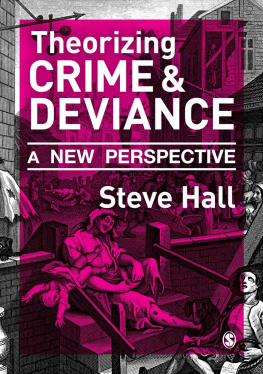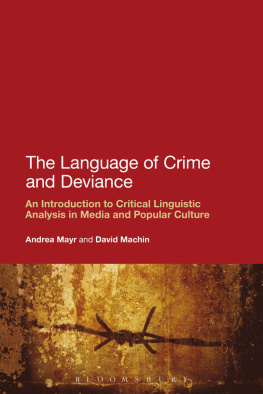Deviance and Crime: Theory, Research and Policy, Third Edition
First published 2005 by Anderson Publishing
Published 2015 by Routledge
2 Park Square, Milton Park, Abingdon, Oxon OX14 4RN
and by Routledge
711 Third Avenue, New York, NY 10017, USA
Routlege is an imprint of the Taylor & Francis Group, an informa business
Copyright 2005 Taylor & Francis. All rights reserved
No part of this book may be reprinted or reproduced or utilised in any form or by any electronic, mechanical, or other means, now known or hereafter invented, including photocopying and recording, or in any information storage or retrieval system, without permission in writing from the publishers.
Notices
No responsibility is assumed by the publisher for any injury and/or damage to persons or property as a matter of products liability, negligence or otherwise, or from any use of operation of any methods, products, instructions or ideas contained in the material herein.
Practitioners and researchers must always rely on their own experience and knowledge in evaluating and using any information, methods, compounds, or experiments described herein. In using such information or methods they should be mindful of their own safety and the safety of others, including parties for whom they have a professional responsibility.
Product or corporate names may be trademarks or registered trademarks, and are used only for identification and explanation without intent to infringe.
Library of Congress Cataloging-in-Publication Data
DeKeseredy, Walter S., 1959-
Deviance and crime : theory, research and policy / Walter S. DeKeseredy, Desmond Ellis,
Shahid Alvi.3rd ed.
p. cm.
Includes bibliographical references and index.
1. Crime. 2. Deviant behavior. 3. Criminology. I. Ellis, Desmond. II. Alvi, Shahid. III. Title.
HV6025.D354 2005
364.3--dc22 2005003540
ISBN 978-1-58360-549-3 (pbk)
Cover design by Tin Box Studio, Inc./Cincinnati, Ohio
E DITOR Ellen S. Boyne
A CQUISITIONS E DITOR Michael C. Braswell
This book was supposed to be the third edition of The Wrong Stuff: An Introduction to the Sociological Study of Deviance . However, constructive suggestions made by Michael C. Braswell (our close friend and Acquisitions Editor) and some anonymous reviewers influenced us to change the title and to focus on theories, research, and policies omitted from the first two editions of The Wrong Stuff . Despite the new title and the inclusion of new scholarly work, the primary objective of this book is the same: to introduce students to the sociological study of deviance, crime, and social control. This involves a two-step process. The first step is to show the influence of classical and general sociological theories on five major, contemporary theoretical perspectives. The second step is to apply these five perspectives to substantive topics such as woman abuse, corporate crime, and homicide.
The five theoretical perspectives covered include strain, social control, interactionist, ecological, and critical perspectives. They are regarded as standard theoretical perspectives because each one is well established in the sociology of deviance, crime, and social control. Most sociologists who study these topics either use one of them or some combination of elements borrowed from more than one. This does not mean, however, that all sociologists who study deviance, crime, and social control would place any given theoretical perspective under the same general title we selected. Here, as elsewhere, there is a lot of room for differences in judgment.
We also provide a comprehensive, highly intelligible overview of sociological research on five substantive topics. Of course, we could have covered many more, and several other texts do. However, we limited our focus to only fivenot because we think others are unimportant or of little social consequence. Rather, we decided to replace the standard cafeteria conceptcovering a little bit of many kinds of topicswith the concept of table dhte , presenting a few selected offerings. These are limited in number, so that each topic can be covered in some depth, an approach we believe necessary for acquiring more than superficial knowledge of it.
It cannot be emphasized enough that we wanted to avoid what Walter DeKeseredy and Martin D. Schwartz refer to in their book Contemporary Criminology as the immunization factor of crime theory. That is, you read about theory in one or two chapters and are now immunized and never have to read about it again. Again, in Deviance and Crime , we always return to theories when covering substantive topics like homicide and woman abuse. Rather than just describe the extent and distribution of these problems, we also show how different theories explain them. This is a highly effective way of showing students that there is more than one way to explain any type of deviance, crime, or method of social control.
What is to be done about deviance, crime, and social control? Of course, there are many conflicting answers to this question, all of which are informed by theories. In this book, we provide some example of policies derived from the above five major theoretical perspectives. As stated in , none of the theories reviewed in this text have a monopoly on any particular solution. For example, because strain theorists and critical theorists are deeply concerned about the criminogenic consequences of inequality, it is not surprising that both groups propose policies aimed at reducing this problem. Moreover, just because critical theorists call for a transition to a socialist feminist society does not mean that they disregard criminal justice reform, an issue that is also of central concern to conservative scholars.
Definitions, research, theories, and policies are described in a way that will make the sociological study of deviance, crime, and social control come alive. For example, whenever possible, we provide real-life anecdotes to illustrate complex issues. Sometimes, these anecdotes are about our own lives. Some scholars may claim that this approach is unorthodox, but it is how many of us learn. Indeed, all of us have either directly or indirectly experienced crime, deviance, and social control. These arent things that only happen to other people.
While we try to be as fair as possible, this is not a value-free book. For example, with its decidedly sociological orientation, it sees a smaller role for biological and psychological theories of deviance and crime. Moreover, Deviance and Crime devotes attention to theorists and topics that are often ignored or given superficial treatment in other texts. In particular, critical criminological theories are given considerable attention here. Still, the strengths and weaknesses of the critical offerings reviewed are noted.
Each chapter attempts to engage and involve the reader in a dialog with the authors, with her/himself, with other students, and with the people quoted or referred to in this text. To achieve this goal, discussion questions, problemsolving scenarios, suggested readings, and online resources are included at the end of every chapter. Further, Deviance and Crime is accompanied by an instructors manual and PowerPoint presentations for each chapter. We hope instructors and students will find these supplements useful and we look forward to hearing their feedback.
In his groundbreaking book Confronting Crime: An American Challenge , Elliott Currie (1985:vii) correctly points out that [m]ost books about social questions are, to a much greater extent than is usually recognized, the products of collective effort. The same can be said about this one. Each of us has always been keenly interested in deviance, crime, and social control, and we wanted to co-author a book such as this for years. However, if it were not for the encouragement and support of Michael C. Braswell, Ellen Boyne, and other staff at Lexis Nexis Anderson Publishing, this project would not have come to fruition. Deviance and Crime was a long time coming and we deeply appreciate these colleagues patience and guidance. Special thanks also go to Emily Troshynski, who devoted long hours to copy editing each chapter.




